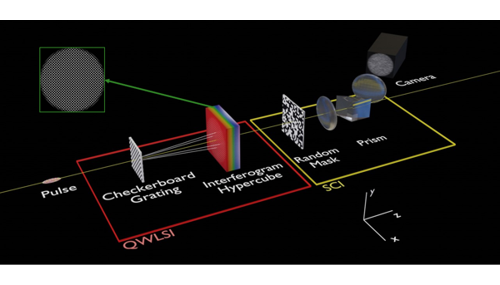Ultrashort laser pulses have broad spectral bandwidth, which can result in the formation of spatio-temporal couplings (STCs) that affect their behaviour. These couplings, arising from the chromatic properties of optical elements, can cause spatial and temporal changes in the pulse, such as the reduction of its peak intensity. However, deliberate manipulation of STCs can lead to unique light pulses with applications in various fields, such as laser-driven wakefield accelerators and orbital angular momentum beams. The expanding use of ultrafast laser pulses in different applications has created a demand for robust methods to measure their properties. Resolving STCs requires obtaining wavefront information over a three-dimensional hypercube of position and time (or spectra). Most existing techniques rely on scanning over one or two of the dimensions; for example, by using array sensors like CMOS cameras. However, these methods are time-consuming, unable to capture shot-to-shot variations and laser drift, and often lack resolution and spectral range. While there are some single-shot methods available, they currently suffer from low resolution, limited spectral range, and implementation challenges.
Taking inspiration from the recent influx of machine learning methods being applied to laser science, the presented technique achieves a high-resolution single-shot measurement of the spatio-temporal wavefront by combining a conventional wavefront sensor with Snapshot Compressive Imaging – a computer vision method that aims to recover three-dimensional data from a single capture of a two-dimensional sensor. The pulse is first passed through a wavefront sensor, such as the quadriwave lateral shearing interferometer (QWLSI) used in this report, although other wavefront sensors are also applicable. The QWLSI uses a checkboard grating to create four laterally sheared copies of the pulse, leading to the gradient of the wavefront being encoded in an interferogram. As the pulse travels through the QWLSI, the spatial wavefront of each spectral slice is encoded into an interferogram, yielding a hypercube of interferograms that contains the encoded spatio-temporal wavefront information. In conventional wavefront sensing, here one would use a camera to integrate over the spectral dimension yielding a single interferogram; but this would prevent the extraction of the spectral phase. Instead, one can utilise snapshot compressive imaging (SCI) to capture the full cube. This approach is based on the principles of compressed sensing, and works by first randomly sampling the cube onto the two-dimensional sensor using an optical setup consisting of a random transmission mask and a dispersive element. What is captured on the sensor is termed the coded shot. Machine learning techniques are then able to reconstruct the three-dimensional information from this with high accuracy. Here, the spatio-temporal wavefront can be recovered by two subsequent reconstructions; firstly, the hypercube of interferograms from the coded shot, and finally the spatio-temporal wavefront is recovered from this hypercube. A schematic of the optical set up and a reconstruction is shown in figures 1 and 2 respectively.
The technique was proposed by a collaboration of research groups from the University of Oxford and LMU Munich, and represented the first time that wavefront sensing had been combined with snapshot compressive imaging. They implemented a state-of-the-art deep unrolling algorithm to perform the snapshot compressive imaging reconstruction, which represents an optimum compromise between well generalising iterative algorithms and highly expressive neural networks. Furthermore, they used a convolutional neural network (Xception) to perform the reconstruction of the wavefront from the interferograms, which allows for a large speed increase over existing methods (such as Fourier filtering), and could potentially enable a live optimization of the pulse in the future. The QWLSI was chosen due to the fact that each interferogram contains the information of two sets of orthogonal gradients, and this redundancy allows for a more robust reconstruction.
"Existing methods to characterise spatio-temporal couplings in ultrashort laser pulses are cumbersome to implement and require many shots," explains Sunny Howard, a DPhil student at the University of Oxford. "Our proposed method achieves a high-resolution characterisation in a single shot, allowing for the detection of shot-to-shot variations and the potential of live optimization."
Follow on work will include the experimental realisation of this technique, and the use of it to characterise the ATLAS-3000 Laser at the Center for Advanced Laser Applications (CALA). In the future, the device is hoped to be used to optimize exotic light pulses, such as those possessing orbital angular momentum.
The research results are published in High Power Laser Science and Engineering, Volume 11, Issue 3 (Sunny Howard, Jannik Esslinger, Robin H. W. Wang, Peter Norreys, Andreas Döpp. Hyperspectral compressive wavefront sensing[J]. High Power Laser Science and Engineering, 2023, 11(3): 03000e32).

Figure 1: The optical setup. The pulse travels through the QWLSI yielding an interferogram hypercube that contains the desired spatio-temporal wavefront information. This is then captured using SCI, by the random sampling of the cube using a random mask and a prism. The camera captures the coded shot.


